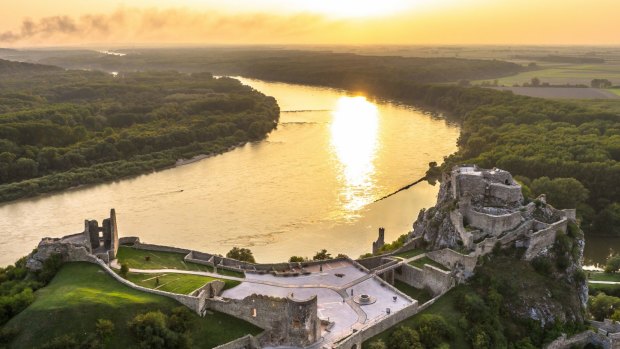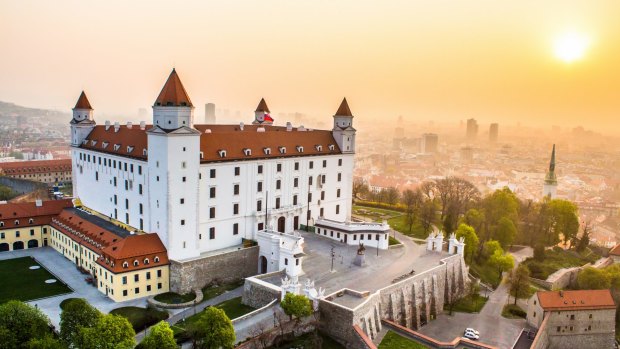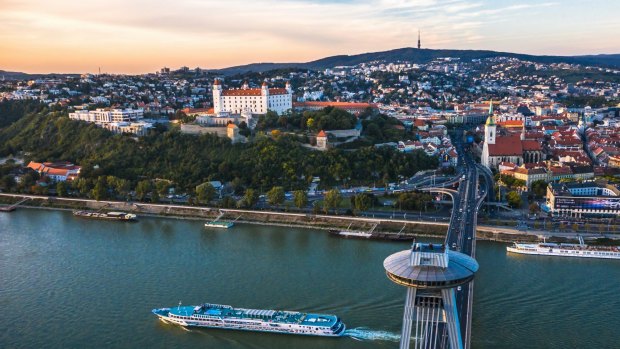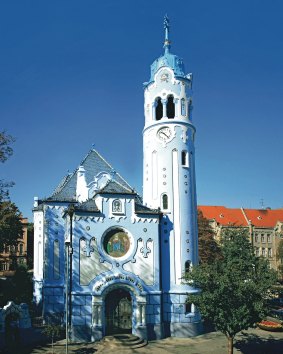This was published 6 years ago
Bratislava, Slovakia: a stunning stop on a cruise down the Danube

The Danube, Bratislava.Credit: MS Agency
Loosely speaking, Slovakia's capital, Bratislava, straddling the Danube River, is an excellent example of German writer Johann Wolfgang von Goethe's observation that "architecture is frozen music".
You only have to look down from hilltop Bratislava Castle to see how the city's architecture starkly reflects history's extremes. On one riverbank are the gilded verdigris spires and handsome pastel-coloured Baroque and Renaissance buildings of the Old Town. Across the river sprawl the brutalist concrete Soviet-style "panelak" (pre-fabricated panel apartments) once called "undignified rabbit hutches slated for demolition".
Different architectural periods in this landlocked central European city illustrate how the city's designers have "painted" with building materials to express different political realities.

Bratislava's old town.Credit: MS Agency
What visitors see is the frozen music of time, sometimes discordant but always significant as a concrete reminder of the tide of life. We've come to Bratislava as part of our 15-day APT Magnificent Europe river cruise. Our ship, the AmaBella, has sailed north from Budapest before turning west at the Danube Knee where the river forms the border between Hungary and Slovakia.
We have in fact cruised past Bratislava, crossing the Austrian border to dock in Vienna. This "freedom of choice" Bratislava tour takes us 80 kilometres back into Slovakia to absorb the rich past of one of the world's newest countries.
Nothing remains of the former Iron Curtain border (where about 700 border patrol officers were apparently accidentally shot by their colleagues) apart from abandoned missile silos where nuclear warheads once were stored.

Bratislava embraces architecture old and new.Credit: MS Agency
This is my second visit to Bratislava, whose name means "glorious city of the brotherhood of nations". On the first, it was the Old Town or Stari Grad, reminiscent of Prague and Vienna that fascinated, despite the abundance of fly-in for a bucks weekend imbeciles.
Our entertaining guide, Uri, takes us on a walking tour through this historic centre, passing must-see beauties including St Michael's Gate and Tower, the castle, St Martin's Cathedral, the Main Square and medieval Old Town Hall, the Franciscan Square, the rococo-style Mirbach's Palace, the neoclassical Primatial Palace, the blue church of St Elizabeth's and the Bratislava National Theatre.
However it is Uri's commentary on influences architectural and historic from Slovakia's communist past that adds a new dimension. In 1989, the Velvet Revolution ended communist rule in Czechoslovakia. Slovakia became an independent state in 1993 after the peaceful dissolution of Czechoslovakia.

Blue church, Bratislava.Credit: MS Agency
Our guide maintains that 95 per cent of Slovakia's wealthy are former communists and their children. "All profits were privatised and all losses socialised," he says wryly.
In fact, Slovakia, which joined the EU in 2004, has prospered, with a high standard of living, excellent civil liberties, a comprehensive social security system, universal health care, free education and one of the longest paid maternity leave systems in the OECD.
Even the architectural brutalism of the Petrzalka housing project, whose identical apartment blocks were built from 1977, has mellowed. They've acquired thermal heating, colourful facades and are mostly privately owned, according to our guide.
Four decades of communism make it hard for some Bratislavans to appreciate this architecture. It's true that some of it leaves a bit to be desired, with its focus on the odd, sometimes intimidatingly massive raw-concrete structures beloved of former communist countries. Think Big Brother dystopia on steroids.
Bratislava can boast one of the weirdest Soviet-era buildings still standing years after the fall of the Berlin Wall – the upside-down Radio Building that took many years to build. Some refer to this inverted pyramid as the world's ugliest building. It stands alongside the likes of Moldova's concrete circus building, now abandoned, in Chisinau, the Forum Hotel in Krakow, Poland, and Kiev's Hotel Salut.
Another weird and wonderful monument to those times is the 1973 UFO Bridge. Officially, the Bridge of the National Slovak Uprising or Novy Most (New Bridge), it's worth walking across or taking the lift up the bridge pylon to the top of the spaceship 80 metres above the Danube.There's a viewing deck and panoramic views of Bratislava's twin riverbanks, views east and west along the river and north to the Male Karpaty or Small Carpathian mountains.
The Slovak National Gallery is both hated by Slovaks and internationally admired for its interesting if controversial conglomeration of styles. The gallery is in a complex of buildings – the neo-renaissance style Esterhazy Palace, the baroque Water Barracks and the rather menacing socialist addition from the 1970s.
About three minutes' walk from the Old Town is the bleak and unloved concrete wasteland of Namestie Slobody, or Freedom Square, finally receiving a facelift.
A slog up a steep hill from the Old Town centre gets you to Slavin, the memorial monument and military cemetery built in the Stalinist architectural style.
There are many more such monumental mementoes of Soviet-era architecture. For those interested, Authentic Slovakia offers a two-hour post-socialist city tour while e-Architect has custom architecture tours.To know a city's convoluted history is to try and know its people. Bratislava's journey through time seen through its architecture is nothing if not rich and rewarding.
Alison Stewart travelled as a guest of APT.
Trip Notes
MORE
traveller.com.au/cruises/river-cruises
FLY
Singapore Airlines flies daily to Budapest and Amsterdam from Sydney and Melbourne. See singaporeair.com
CRUISE
APT's 15-day Magnificent Europe River Cruise Amsterdam-Budapest and reverse costs $6995 a person with a Fly Free deal or Fly Business Class deal for $2995. Tours operate from March to December. See aptouring.com.au.
Sign up for the Traveller Deals newsletter
Get exclusive travel deals delivered straight to your inbox. Sign up now.